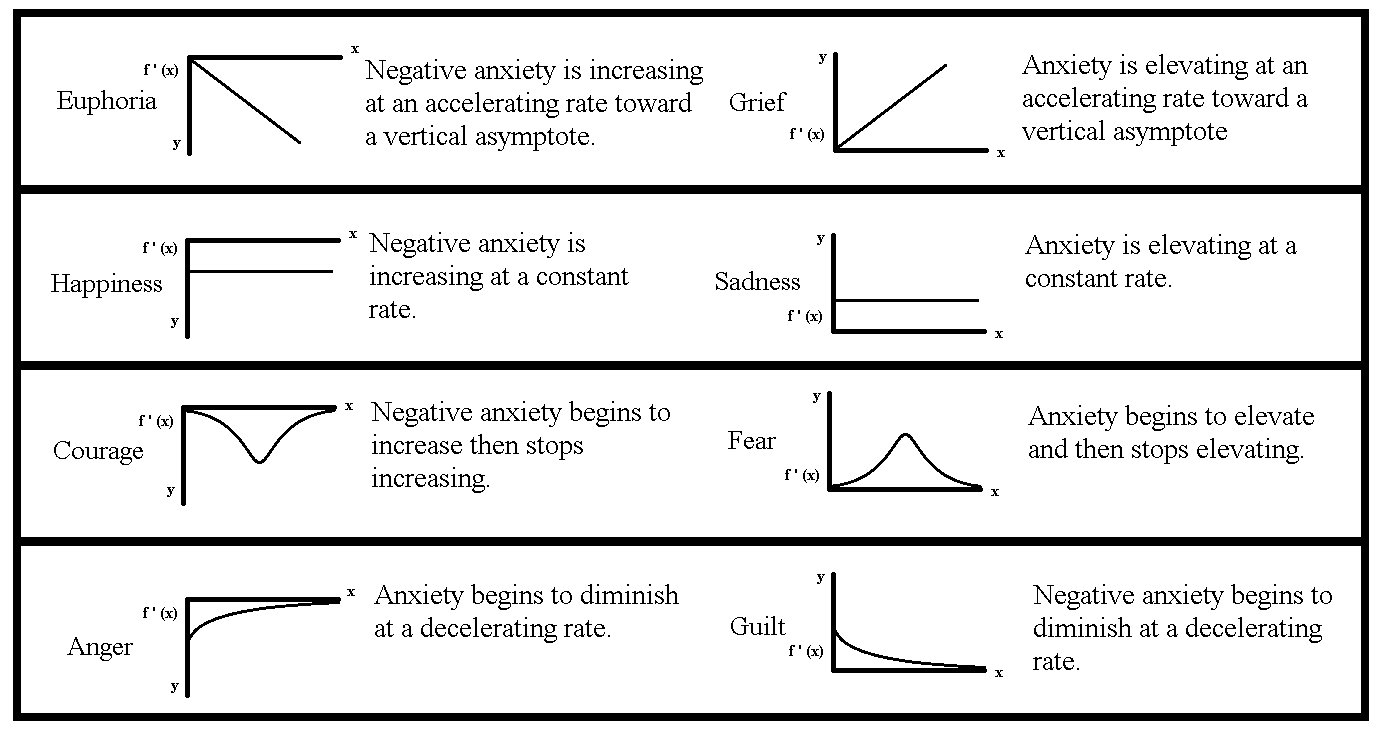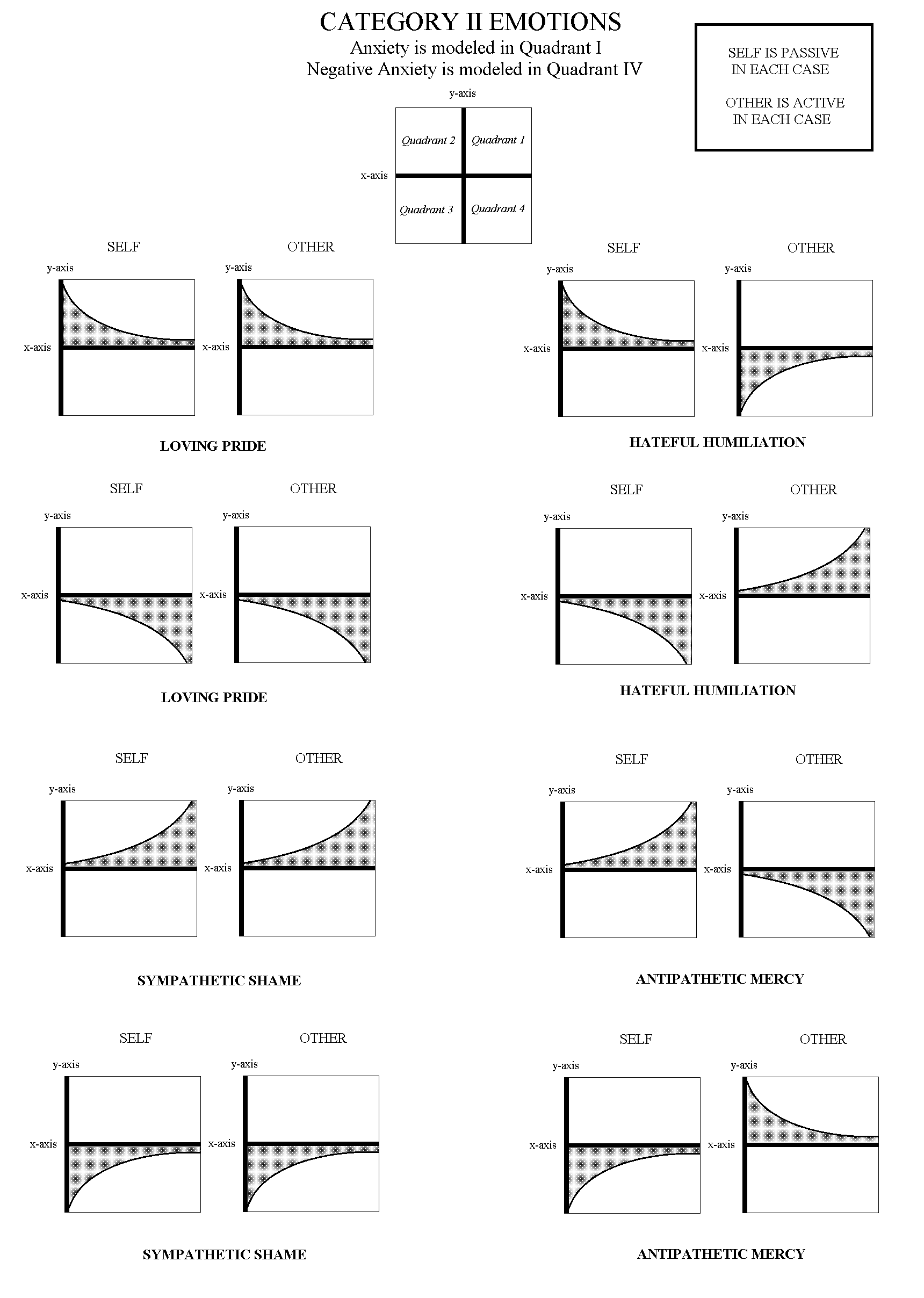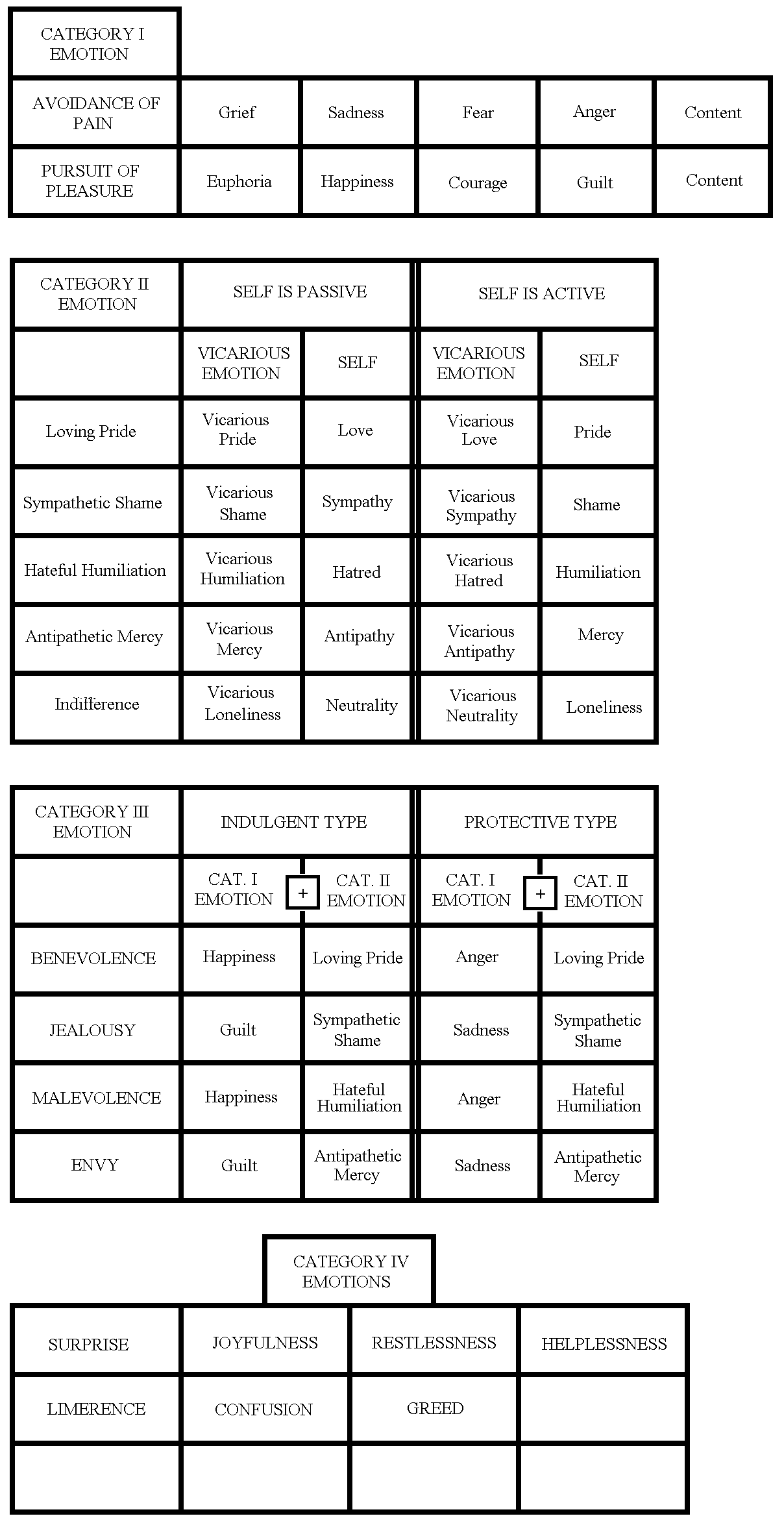The importance of the x-variable, representing Time, can not be overstated. Acknowledgement that deadlines for actions exist if one is to successfully achieve an aim, is crucial to the formation and use of emotions. Without an appreciation of time, which might arise if one had eternal life and youth with all eternity to achieve one’s desires for instance, one’s sense of urgency would dissipate.
Emotions in Affect Engineering are organized into four categories: Intra-personal Emotions (Emotions of the Self); Inter-personal Emotions; Compound Interactive Emotions; and Emotive States. All of them involve change to, or a lack of change to, valuations of entities over time. The versatility of the functions also enables the modeling of projections, that is to say, an individual’s predictions about how they will feel in the future), and flashbacks, concerning the past.
Category One Emotions: Intra-personal Emotions
Intra-personal Emotions consist are comprised of evaluations that solely concern the self and its aims. They are divided into two types, depending on whether the Avoidance of Pain function is being considered or the Pursuit of Pleasure function.
- Avoidance of Pain Emotions: Grief, Sadness, Fear, Anger, and Content.
- Pursuit of Pleasure Emotions: Euphoria, Happiness, Courage, Guilt, Content
Anger is understood in this sense as righteous indignation. Displaced anger on the other hand, concerns actions to mitigate rising levels of anxiety that is misplaced onto a neutral target.
Guilt is understood as a missed opportunity.
The derivative of the function is used to indicate the magnitude of a particular emotion felt for a specific entity as it relates to a specific purpose in Affect Engineering. Grief, Sadness, Fear, and Guilt are similar to the extent that Anxiety rises (Grief, Sadness, Fear) or Negative Anxiety decreases (Guilt). Euphoria, Happiness, Courage, and Anger are similar to the extent that Negative Anxiety increases (Euphoria, Happiness, Courage) or Anxiety decreases (Anger). The slope for Content, in both the Avoidance of Pain and the Pursuit of Pleasure function, is zero.

Figure 11.3 from Affect Engineer: A Unified Field Theory of Emotion p. 506. Category One Emotions: Intra-Personal. The above are graphs representing the slope of the functions being used, that is f’ (x).
Category Two Emotions: Inter-personal Emotions (Four Degrees of Empathy)
Category Two Emotions are purely vicarious experiences where the self desires to either vicariously experience the success of another or vicariously experience the failure of another. This is still in accordance with the 1:1:1:1 Ratio as an individual imagines itself to be a second person. These emotions are described as the Four Degrees of Empathy, but also includes a fifth one, Indifference, or a perceived lack of empathy. These five emotions are Loving Pride, Sympathetic Shame, Hateful Humiliation, Antipathetic Mercy, and Indifference. Depending on whether or not the self is passive and the other is performing the action, or the self is active and perceiving the other to be passive, then these five types have a total of ten different forms they may take on, two for each. Passivity in this instance means that the individual who desires to vicariously experience the success or failure of an other takes no action whatsoever to facilitate the outcome of the active party.

Figure 11.4 from Affect Engineering: A Unified Field Theory of Emotion, p. 507. The Category Two Emotions of Loving Pride, Sympathetic Shame, Antipathetic Mercy, and Hateful Humiliation. Indifference is not pictured, but is comprised either of Vicarious Loneliness with Neutrality (Content) felt by the self if it is passive, or Vicarious Neutrality (Content) with Loneliness felt by the self if it is active.
In short, with the passive forms, the self is simply a spectator. In the active forms, the self perceives others to be simply spectators, that is, the roles are just reversed. In the passive forms:
- Loving Pride consists in the self desiring to vicariously experience the success of an other and the other succeeds
- Sympathetic Shame consists in the self desiring to vicariously experience the success of an other, but the other does not succeed
- Hateful Humiliation consists in the self desiring to vicariously experience the failure of an other, and the other does fail.
- Antipathetic Mercy consists in the self desiring to vicariously experience the failure of an other, but the other succeeds.
- Indifference consists in the self being content (i.e., no changed in Anxiety or Negative Anxiety) regardless of whether or not an other fails or succeeds. This is the absence of empathy.
Category Three Emotions: Compound Interactive Emotions
Category Three Emotions: Compound Interactive Emotions, are distinguished from Category Two Emotions by one feature, both parties are active. This means that the self actively performs an action to influence the outcome for an other. There are four Category Three Emotions: Benevolence, Jealousy, Malevolence, and Envy. They be of two types each, Protective or Indulgent:
- Protective: If Anxiety is at stake for the self, meaning the Avoidance of Pain function is being used
- Indulgent: If Negative Anxiety is at stake for the self, meaning the Pursuit of Pleasure function is being used.
These emotions are essentially combinations of emotions, like the Category Two Emotions. Likewise, the 1:1:1:1 Ratio is upheld because the self imagines itself to be a second person, and more than one purpose is in play.
- Benevolence is comprised of Anger + Loving Pride if Protective, or Happiness + Loving Pride if Indulgent.
- Jealousy is comprised of Sadness + Sympathetic Shame if Protective, or Guilt + Sympathetic Shame if Indulgent.
- Malevolence is comprised of Anger + Hateful Humiliation if Protective, or Happiness + Hateful Humiliation if Indulgent.
- Envy is comprised of Sadness + Antipathetic Mercy if Protective, or Guilt + Antipathetic Mercy if Indulgent.
Jealousy, in this context, is not synonymous with Envy. The former is interpreted more along the lines of psychology, more specifically, as the fear of losing an other’s loyalty or affection to a rival. Though it typically involves a third party, a third party need not be present as literally any entity capable of alleviating an other’s anxiety could potentially become a rival if the self failed to deliver. Coveting can not be included in this definition jealousy, specifically because it would entail the addition of another purpose, which would violate the 1:1:1:1 ratio.
Envy, on the other hand, is understood as contempt for another’s gain. Similarly, coveting is not included in the definition of envy here, as it is a separate purpose.
Category Four Emotions: Emotive States
Category Four Emotions: Emotive States, are generally distinguished by how quickly or slowly they take place over time. This category is more open-ended, as unique and culturally specific emotions can modeled here. While most emotions can be broken down and interpreted as manifestations of the other three categories, a few defy this. Some Category Four Emotions would include Surprise, Restlessness, Joyfulness, Helplessness, and Confusion. Still, other emotions, such as Indifference or Content, seem as if they could fit well into more than one category.
- Surprise, as a Category Four Emotion, is modeled as a sharp increase or decrease in an individual’s valuation of an entity. It does not need to approach a vertical asymptote, and may arise if the Appraisal of an entity changes from positive one to negative one or vice versa. This could occur if something that was originally in ample supply suddenly becomes reduced to a negligible amount (e.g., losing one’s life savings to a stock market crash), or contrarily if something that was direly needed is suddenly acquired in excess (e.g.,. winning the lottery).
- Restlessness is modeled to occur if Anxiety levels (i.e., Emotional Units invested in entities rises to critical levels). This might occur if two or several purposes and recommended courses of action conflict with one another in such a manner that all of the entities useful for their fulfillment become elevated in their appraised value.
- Joyfulness is in essence, the opposite of restlessness in the sense that Negative Anxiety levels (i.e., positive affect), rise to abnormally high levels. This might occur if everything seems to be going one’s way.
- Confusion would be modeled in a function if one or several key variables do not become clear to the individual. Their values may either be unknown or they may be fluctuating in a range that makes it difficult for an individual to determine which course of action to pursue.
- Helplessness would generally be modeled if an individual felt unable to regulate the allocation of Anxiety and Negative Anxiety resources in his or her system (i.e., Emotional Units). This would most often involve the Efficacy variables being abnormally low against Threat, or might also be induced by Attention being directed to Threat and away from Efficacy.



